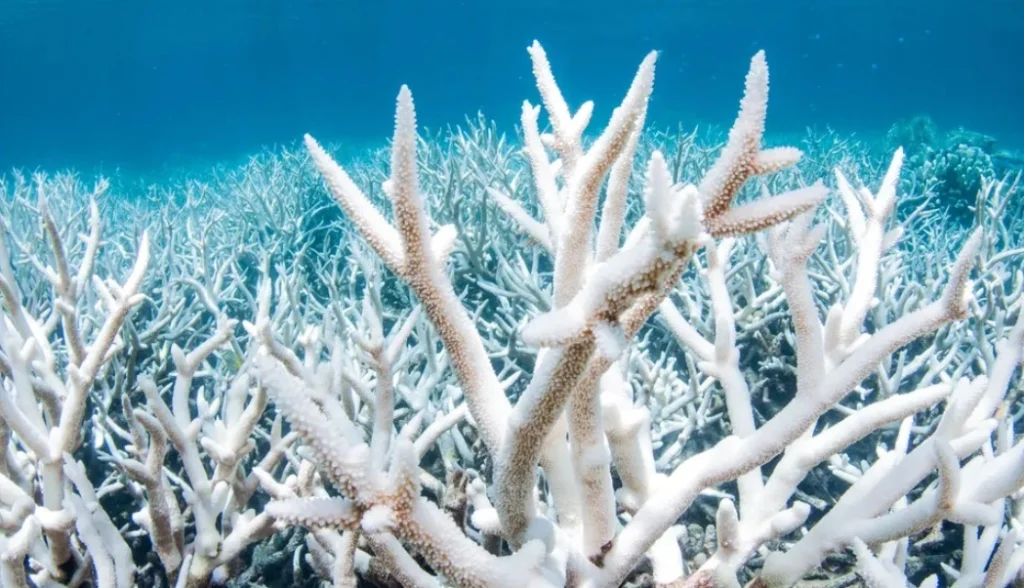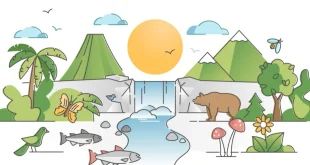
Coral Reefs
These are a few of the most diverse ecosystems in the world. Coral polyps are the animals primarily accountable for building reefs, can take many forms, large reef-building colonies, elegant flowing fans, and even small, solitary organisms. Thousands of species of corals have been discovered. Some live in warm, shallow, tropical seas, and some in the cold, dark deep in the ocean. Corals belong to a class of colonial animals that are associated with hydroids, jellyfish, and sea anemones.
Stony corals are a type of coral characterized by their hard skeleton and are the foundation of the reefs. Stony coral colonies consist of hundreds of thousands of individual living polyps. Polyps are capable enough of drawing dissolved calcium from seawater and hardening it into a hard mineral, calcium carbonate structure that aids as their skeletal support. The thin layer on the surface is live coral and the structure below is the calcium carbonate skeleton. The slow growth of polyps and the development of hard skeletal structures make the permanent coral reef structure over time.
Key Characteristics of Corals
Shallow water, reef-building corals have a symbiotic association with green algae called zooxanthellae, which live in their tissues. The coral offers a protected environment and the components zooxanthellae need for photosynthesis. As a result, the algae produce carbohydrates that are used as food by coral, as well as provide Oxygen. Since both organisms benefit from association, this kind of symbiosis is called mutualism. Deep-sea corals live in deeper or colder oceanic waters and the absence of zooxanthellae. Unlike shallow-water corals, which rely severely on photosynthesis to produce food, deep-sea corals depend on plankton.
Not all coral reefs are stony,
- Hydrocorals, also known as fire coral, are reef-building hydroids that have a hard calcareous exoskeleton and stinging cells. These stinging cells can cause a burning feeling when touched.
- Octocorals, or soft corals that include sea fans and sea whips. These grow more like plump plants, and calcium carbonate skeletal structures do not exist.
- Antipatharians also called black corals, are another type of branching ‘soft’ coral.
Structure
A coral reef has complex features, some part of which is a living coral or algal framework. Some of the other associated structures result from this live segment. The additions of carbonate sand and mud provide a home for sea grasses and mangroves and for almost unremarkable blue-green algal mats. These plants and algae trap and make the sediments stable, and their accumulations are also accreted to the whole reef complex. Storms and surf mound up fragmental material into beaches and shoals, which may develop into low sandy or rubbly islands or cays on top of the reef.
Corals and other Reef-building Organisms
Coral polyps look a lot like sea anemones, to which they are closely related, but, unlike most anemones, most reef corals are found in colonies. Parental polyps divide themselves into daughter polyps, and they divide in turn, rising into colonies that can be up to quite a few meters in diameter, all held together in one continuous rigid calcareous skeleton. The remaining are attached to the seafloor and become so large and heavy that only storms disrupt them. Under accurate conditions, usually, clear and well-circulating water that is not too rough, the corals grow copiously side by side, even on and over each other. The corals in consequence build limestone because their skeletons are made of calcium carbonate.

Calcareous algae also called stony seaweeds, mollusks, echinoderms, and protozoans contribute to the reef. Different organisms have diverse reef-building roles. Some, especially the corals, provide the main fundamental framework of the growing reef, although in parts of the world such as the central Pacific, where the surf is strong, calcareous algae may be more important in irregular places. Shelly, calcareous organisms, and spicule-bearing animals like sponges and sea cucumbers create debris that accumulates among corals.
Types of Corals
Coral reefs have four principal forms.
- Fringing reefs consist of flat reef areas that straight skirt a nonreef island, often volcanic, or a mainland mass.
- Barrier reefs are close to a non-reef landmass but lie several kilometers offshore. These are divided from the landmass by a lagoon or channel often about 50 meters deep.
- Atolls are like circular barrier reefs but central landmass is absent.
- Finally, there are areas, or patch, reefs, which have irregular table-like or pinnacle features: Smaller patches happen inside atoll lagoons.
Major Threats to Coral Reefs
Several forces threaten the survival of coral reef organisms, as well as the structural uprightness of the reefs themselves. Many coral reefs are inundated by predatory species, bleaching, and the effects of various human activities.
Crown-of-Thorns Starfish
Several biological factors, such as the fish and invertebrates that depend on the soft tissues of reef builders and the organisms that bore into coral rocks for food, may contribute to the destruction of coral reefs. one of the most critical creatures known is Acanthaster planci, the crown-of-thorn starfish, which during the 1960s reproduced spectacularly and detached the soft tissues from large areas of many reefs in the southwest Pacific.
A. planci feeds by everting its stomach, liquifying and absorbing the tissues of the corals. By the late 1970s, it had become deceptive, however, that the sudden spread of A. planci was part of the organism’s natural life cycle and that the coral reefs could be restored rapidly after such an invasion. Coral rock borers usually penetrate the rock mechanically but in some cases do so chemically. Extensive damage is caused both by their activities and by the help they give to the erosive actions of the sea.
Coral Bleaching
A phenomenon known as bleaching caused widespread destruction among coral reefs in the East Pacific since the early 1980s and in the Caribbean since the mid-to-late 1980s. It is called bleaching because zooxanthellae, which are golden-brown are banished, leaving the white coral exposed. While the cause of bleaching is not yet completely known and extensive research is going on, it is believed that the most likely factor is remarkably high seawater temperatures, approximately 30 °C.

Other factors related to coral bleaching include rising acidity due to the increased absorption of carbon dioxide by the oceans, ultraviolet radiation exposure, drying from extreme low tide events such as those associated with El Nino, sedimentation, pollution, and disease.
Other Threats
A living coral reef may have the potential as a major tourist attraction. by touching corals and destroying the other animals that live there, visitors to the reef may affect the community dynamics of the reef system. Since coral reefs protect many species of fish and other sea life, local and commercial fishing can overharvest them.
In their efforts to capture the animals of the reef, fishers may use dragnets and explosives. Such practices scrub or break up sections of the coral reefs, destroying the corals and the various individual habitats they may provide. some coral reefs may be masked by additional sedimentation from terrestrial erosion. This may prevent reef plants from obtaining suitable sunlight or may promote the growth of harmful algal blooms. https://www.epa.gov/coral-reefs/what-you-can-do-help-protect-coral-reefs

 The Climent Respect your roots, Protect your planet
The Climent Respect your roots, Protect your planet
